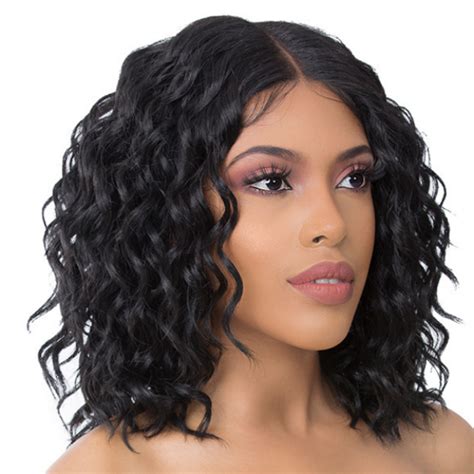What is a Wig?
A wig is a covering for the head made from human hair, synthetic fibers, or a combination of both. It is designed to resemble natural hair and is worn for a variety of reasons, including fashion, religious purposes, and medical conditions.

Types of Wigs
There are numerous types of wigs available, each with its own unique characteristics.
Lace Front Wigs
- Made with a thin, sheer lace that creates a realistic hairline
- Can be customized and styled to blend seamlessly with natural hair
- Offer a more natural appearance than traditional wigs
Full Lace Wigs
- Constructed entirely from a lace cap
- Allow for maximum breathability and comfort
- Provide the most versatile styling options
Synthetic Wigs
- Made from artificial fibers
- Affordable and easy to style
- Less durable than human hair wigs
Human Hair Wigs
- Made from natural human hair
- More expensive and require more maintenance than synthetic wigs
- Provide the most natural look and feel
Benefits of Wearing Wigs
- Enhance your appearance: Wigs can instantly transform your look and boost your confidence.
- Protect your hair: Wigs can shield your hair from damage caused by heat styling, harsh chemicals, and environmental factors.
- Experiment with different styles: Wigs allow you to try out new hair colors, lengths, and textures without committing to a permanent change.
- Cover hair loss: Wigs can conceal hair loss caused by medical conditions, such as alopecia and chemotherapy.
Choosing the Right Wig
When selecting a wig, there are several factors to consider:
- Face shape: Choose a wig that complements the shape of your face.
- Hair texture: Match the texture of your wig to your natural hair or desired look.
- Color: Select a wig that matches your skin tone and hair color, or experiment with different hues for a bold change.
- Style: Consider your lifestyle and preferences when choosing a wig style that suits your needs.
Caring for Your Wig
Proper care is essential to prolong the life of your wig.
Human Hair Wigs
- Wash with sulfate-free shampoo and conditioner
- Use wide-tooth combs or brushes
- Avoid heat styling as much as possible
- Store in a cool, dry place
Synthetic Wigs
- Wash with a mild detergent or wig shampoo
- Use only a wide-tooth comb
- Do not heat style
- Store in a cool, dry place
Wig Industry Statistics
- The global wig market size is projected to reach $16.6 billion by 2028.
- The United States is the largest wig market, accounting for over 30% of global sales.
- The increasing incidence of hair loss and a rise in disposable income are driving the growth of the wig industry.
Innovative Wig Applications
Beyond traditional uses, wigs are finding new applications in various fields:
- Medical: Wigs can restore hair loss in patients undergoing cancer treatment or experiencing other medical conditions.
- Cosplay: Wigs allow individuals to transform into their favorite characters for conventions and events.
- Fashion: Wigs are increasingly popular in the fashion industry, enabling celebrities and models to experiment with daring looks.
- Theater and Film: Wigs are essential for creating authentic period costumes and character portrayals.
Tables
Table 1: Wig Types and Characteristics
| Wig Type | Material | Appearance | Customization | Durability |
|---|---|---|---|---|
| Lace Front | Lace and hair | Realistic hairline | High | Medium |
| Full Lace | Lace only | Natural look | Maximum | Low |
| Synthetic | Artificial fibers | Affordable | Easy | Low |
| Human Hair | Natural hair | Most realistic | High | High |
Table 2: Wig Benefits
| Benefit | Purpose |
|---|---|
| Enhance appearance | Boost confidence and transform look |
| Protect hair | Shield from damage and harsh chemicals |
| Experiment with styles | Try different colors, lengths, and textures |
| Cover hair loss | Conceal medical hair loss conditions |
Table 3: Wig Care Instructions
| Wig Type | Shampoo | Conditioner | Styling | Storage |
|---|---|---|---|---|
| Human Hair | Sulfate-free | Sulfate-free | Heat style with caution | Cool, dry place |
| Synthetic | Mild detergent or wig shampoo | Not required | Do not heat style | Cool, dry place |
Table 4: Wig Industry Statistics
| Statistic | Value |
|---|---|
| Global wig market size (2028) | $16.6 billion |
| Largest wig market | United States |
| Major growth factors | Hair loss incidence and disposable income |
FAQs
1. What is the difference between a lace front wig and a full lace wig?
- Lace front wigs have a lace panel along the hairline, while full lace wigs are made entirely of lace.
2. How long do wigs last?
- The lifespan of a wig depends on the type, care, and frequency of use. Human hair wigs can last 1-2 years, while synthetic wigs typically last 3-6 months.
3. Can I wash my wig?
- Yes, wigs can be washed. Use a mild detergent or wig shampoo and avoid harsh treatments.
4. How do I store my wig when not in use?
- Store wigs in a cool, dry place, away from direct sunlight. Use a wig stand or box to maintain its shape.
5. Can I dye my wig?
- Some wigs can be dyed, but it is recommended to consult a professional to ensure the dye is compatible with the wig material.
6. How do I style my wig?
- Use products designed specifically for wigs. Avoid heat styling as much as possible.
7. Can I wear my wig during sleep?
- It is not recommended to wear a wig while sleeping, as it can cause friction and damage the wig.
8. Where can I buy a wig?
- Wigs can be purchased from hair salons, beauty supply stores, and online retailers.
